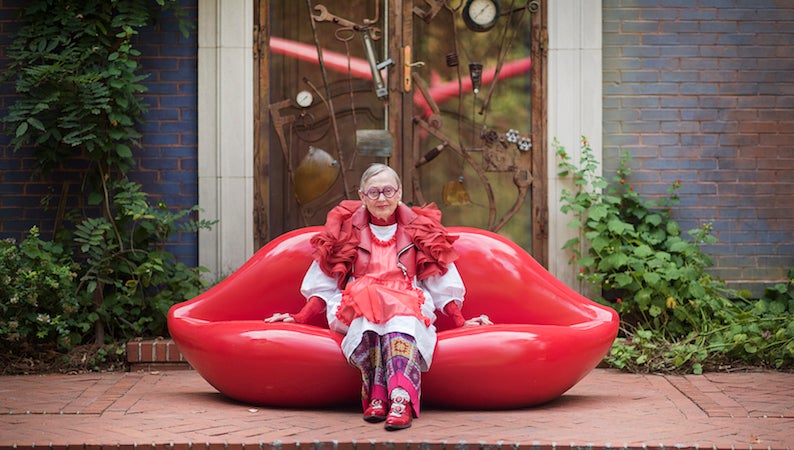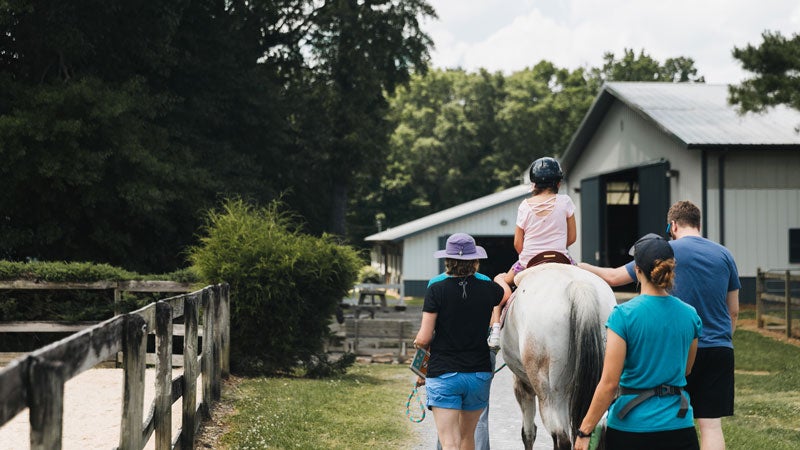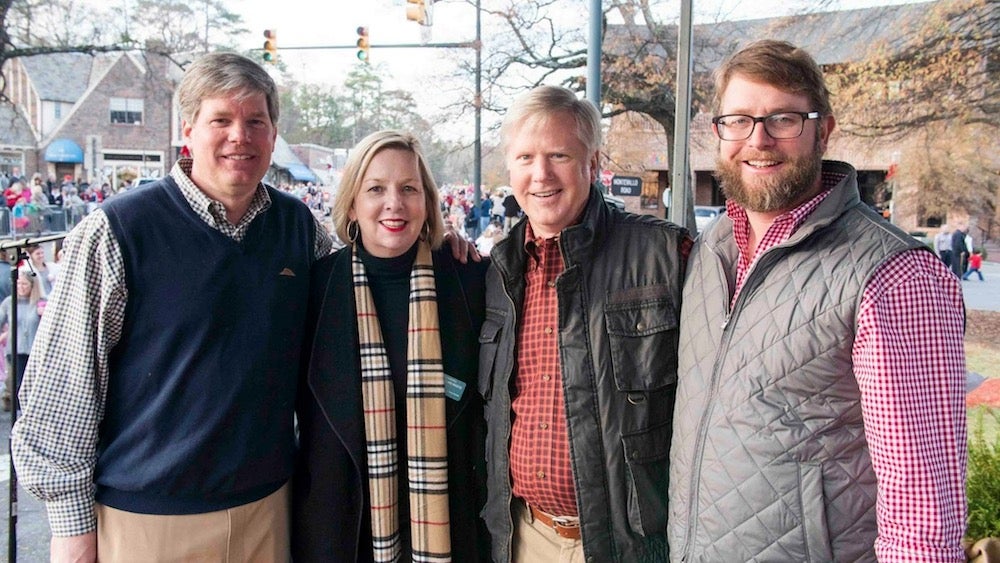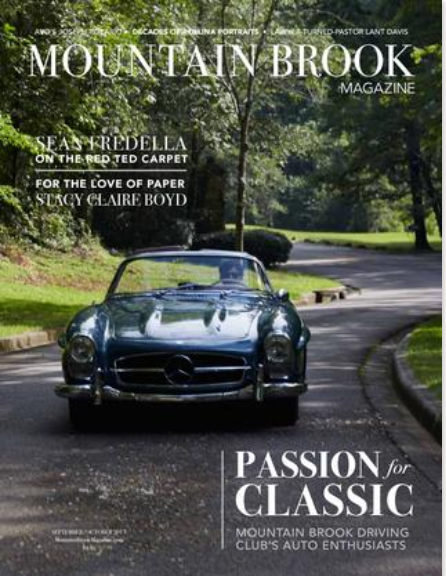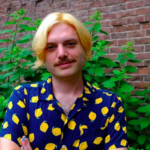When they were children, Margot and Caroline Wade liked to hide under a table in the entry way of their grandparents’ home during parties to listen for guests’ reactions when they walked in to find a montage of the girls’ grandmother Carolyn’s oversized mannequin sculptures and their grandfather Robin’s hunting prizes—all after noticing a “crime scene” with mannequins on the house’s roof lit by spotlights before entering.
Likewise, Margot, now Margot Wade Cooney, vividly remembers the day she and Caroline came over to their grandparents’ house to discover its country white exterior had been painted vibrant purple. But what she always noticed the most in the home was her grandmother’s artwork that engaged all five of her senses. Everyone else’s work always came second. “I thought it was so cool my grandmother made it,” she recalls. “My grandmother never did small art. It’s massive—her tapestries, her statues, everything—it’s a massive labor of love.”
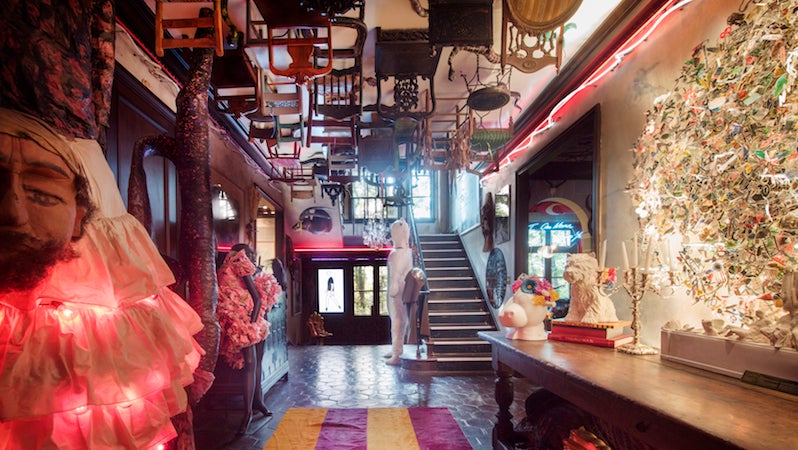
Walking into the Wade home you are greeted by the shock and awe of the home full-on with chairs on the ceiling and, if you look a bit closer, you’ll stumble upon the snakes too.
The animal heads have since migrated from the entryway of the home to the former garage space and the roof no longer bears a crime scene, but the house still has as much of a shock and awe factor as when Margot and Caroline, now 32, were children, if not more.
Today what you see in the Wades’ museum of a home is the result of 44 years of metamorphosis, redoing each space in the home room by room to share the art they have discovered on their worldwide travels and that they have invited local artist and others to create.
Because it’s an art house, it’s constantly changing. Pieces are always being added but none are ever removed. Not a wall or ceiling is untouched, and each piece has a purpose. What stays constant is Carolyn’s preference largely for work by female artists and in particular etchings by Kiki Smith, a contemporary artist known for visceral depictions of the human body in detail.
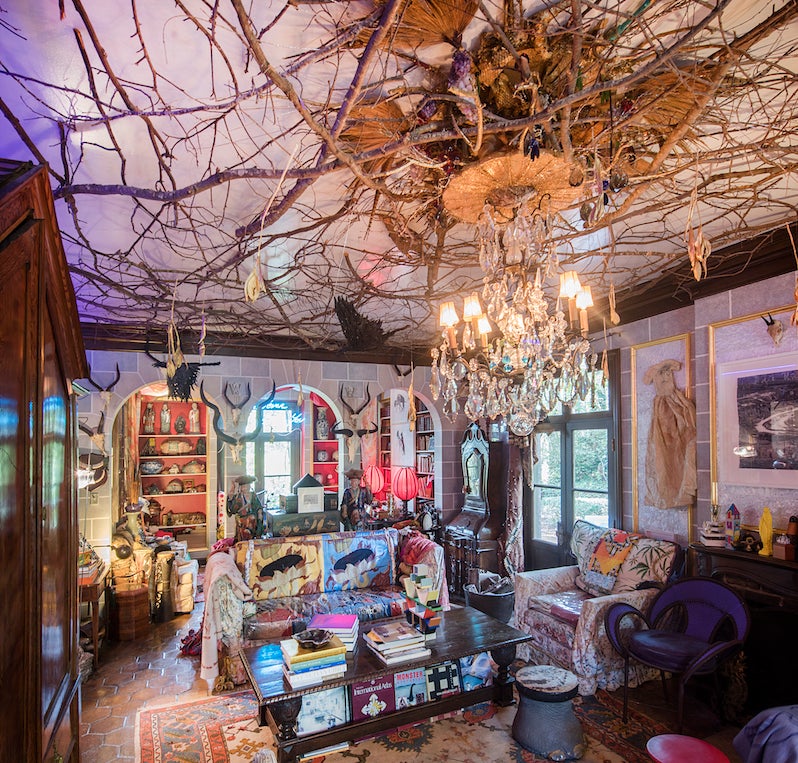
Much of the pieces in the living room are a fun take on what a grandparents’ house should look like, with plastic and drop cloths covering pieces, and features a mix of art, antiques and artifacts. Like all rooms in the home, it bears its own unique ceiling décor, here birds and branches alike.
In each room, you’d be remiss not to look up. It starts in the dog trot entry way with a set of chairs in all shapes and colors above your head, and upon closer observation, snakes sprinkled throughout them to add to the shock factor. In the dining room you’ll see a gold leaf ceiling with chrome water drains interspersed. In the kitchen, it’s pots and pans and car pieces, and in the breakfast room it’s an email correspondence in response to Margot’s artwork interlaced with one her grandmother’s old dresses. In the living room branches and birds line the ceiling, and the master bedroom white rocks signifying Robin’s work in quarries and heavy things that are also light do.
Also throughout the home guests see pieces commissioned for Birmingham artists Peter Prinz and Anne Arrasmith. In the dining room alone, they created an interpretation of a buffet bearing depictions of the Vulcan and each Wade family member’s home sitting between African mud cloths that act as curtains with spears used as curtain rods. Even the seat cushions in the dining room were custom by Anne Arrasmith.
But the Wade house looked quite different when the family moved to Cherokee Road with their children on the first day of 1975. At first the décor of the home was traditional just like its architecture, with antiques sitting amongst paisley wallpaper. That started to change after Carolyn’s children went off to college and she studied studio art and art history at UAB. She’ll tell you it changed her life—and it certainly changed many others’ too. “Her art has helped teach people in Birmingham about modern art and art in general,” Margot says. “It’s a space you walk into and just get to see art instead of looking at slides.”
Travels crystalized this change for the Wades and their home too. Over the years Robin and Carolyn would go on trips that curators from the Guggenheim Museum and the Whitney Museum of American Art led over the world to see private collections and art that was local to the area. Today their walls bear memories from each of those trips and artists they discovered.
In other ways, art was nothing new to Carolyn even before taking up her studies though. She’d always been a talented needle pointer, but her repertoire expanded to experimental art that engages the whole person, crafting mannequins and extra large abstract needlepoints that could take up to two years to complete—Margot’s favorite of her grandmother’s works.
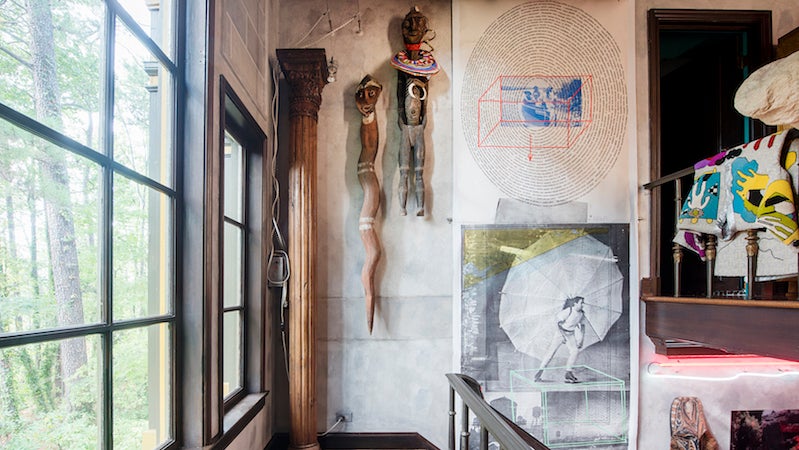
Artwork by Robert Rauschenberg and Gerhard Richter as well as and Dani Tribe artifacts line the stairway from the first floor to the second, and a needlepoint jacket by Carolyn Wade hangs over the rail on the right.
Once each of their four grandchildren turned 10, Carolyn and Robin started taking them on trips too. ”They wanted us to see what was outside Alabama and what London and Rome look like, what cannibals in Indonesia look like,” Margot recalls. Just like their grandparents’ journey from general to specific travels, they began to see curated art as they got older, looking closer at the inner workings of the city instead of just the framework in Africa, India, Indonesia and all over Europe.
Today Margot’s three children, ages 5, 3, and 2, love to go to their great-grandparents’ house just like Margot did. “People ask if they are amazed, but it’s so normal to them,” Margot says. “They want to play with the trains. They know it’s a gem, but they want to spend time with their great-grandparents.”
Their memories are not unlike Margot’s own from childhood. Growing up she and her sisters never watched TV there—except for the high fashion shows Carolyn recorded. Instead they learned to knit from Carolyn, and their granddad Robin—whom Margot calls an “amazingly inquisitive man” who is “always learning, always excited to do something new”—would get an 80 foot-rope, tie knots into it and have his grandchildren figure out how to undo them.
Margot went on to study art at Mount Holyoke College and work in sculpture, but her studies would just build on what she’d learned growing up. “My grandparents always talked about art as a lifestyle,” she says. “It’s how you approach any situation. My grandfather is a scientist and a businessman, but the reason he is so good at those is because he’s creative and because he’s curious. My grandmother has this amazing attention to detail and this endurance. Somewhere it was in my bones that I too can build something big.”
While earning her master’s degree in art, Margot was learning about how a big issue with personal art collections is that owners don’t know what they have. So when she graduated she went in every room of her grandparents’ home to catalogue what art was in it and where it was from.
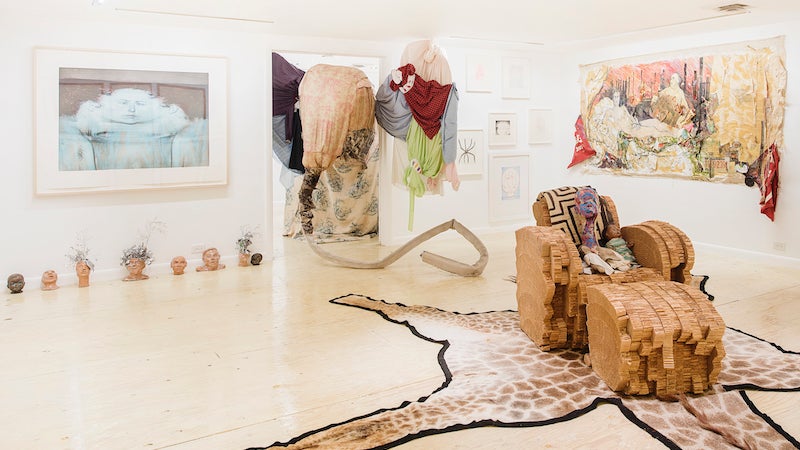
From this view of the attic, in the back center you can see a 13-foot tall elephant Margot sculpted out of objects she found in her grandparents’ attic—night gowns, pillows, bed sheets, a gun case, medicine cabinet, you name it—that is now installed with its base on the second floor beneath it. To the right is a cardboard chair by architect Frank Gehry—one of many pieces added after an artist was featured at Space One Eleven and that artist visited the Wade home, and above it is an imagination of Manet’s “Olympia” featuring Birmingham relics by Anne Arrasmith.
Later she’d sculpt a 13-foot tall elephant out of objects she found in her grandparents’ attic—night gowns, pillows, bed sheets, a gun case, medicine cabinet, you name it—for an installation at Space One Eleven downtown. “Why go to an art store and get art supplies when you have something way more meaningful here?” Margot notes. “We are very sentimental people. If you make it into art you don’t have to throw it away.” Today the elephant is installed half in the second floor of the Wade home and half in the now cleaned-out attic that Peter Prinz and Anne Arrasmith transformed into a bright white cube gallery featuring other works and capsules of other materials from the attic storage space curated by family members too.
Touring around the house, Margot and Carolyn pause over and over again to tell you not just about their own work but all the more so about the artists behind the other works you are seeing here. How Birmingham isn’t the same without Anne Arrasmith (she passed away in 2017), who made art about AIDS when no one was talking about it. How Maria Magdalena Campos-Pons found her voice in post-revolutionary Cuba. How Kara Walker reimagined depictions of the Southern tradition allow you to dialogue about race relations in the region. How they made phone calls over days to Robert Rauschenberg to make sure his work was installed just as he would have wanted. And how Carolyn herself got war shields from New Guinea.
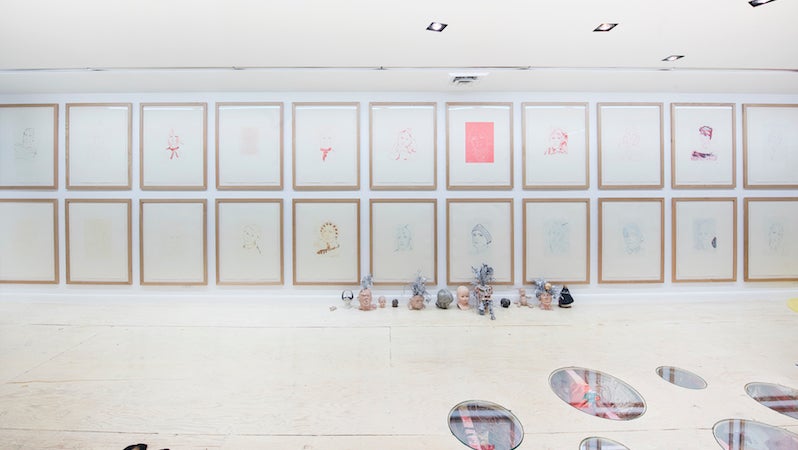
Normally one or two pieces of an artist’s work would be in a gallery or museum, but here you can see Thomas Schulte’s entire thought process evolution on this wall space in the attic’s white cube gallery. Beneath it are capsules curated by Peter Prinz and Anne Arrasmith from objects from the Wades’ attic.
It’s a tour they started giving Altamont School art history classes when Margot and her siblings were students there, and seemingly any time an artist or Birmingham Museum of Art guest speaker, where Carolyn serves on the board, came to town, the Wades would throw a party, opening their home for various tours too. Because of the parties, word travelled fast about the purple house on top of the hill with this spider out front. And all who have visited or call can agree that it’s equally eccentric, artful and life-changing.

